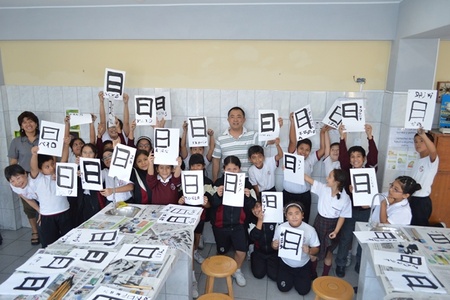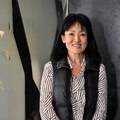
Vocation sometimes comes in the most unique ways. Hamano Ryuho remembers that he was about four years old when he inadvertently began to write. He did it as if playing, making marks on the ground with a stick.
He also remembers how much he liked the shapes of the ideograms. “When I was a child, the times I went to the cemetery, I saw the kanji engraved on the tombstones, and with my fingers I began to mark the contours, the shapes of the letters,” he says, almost surprised by this unusual habit that was perhaps premonitory.
That early attraction to writing led him to become a shodō (artistic calligraphy) artist and a stamp engraver, two professions that very few people pursue in today's Japan. Although both have specific techniques (how to write each stroke, for example), each artist gives it their own personality.
The beauty of simplicity
His creative process begins with the contact he has with the suzuri , the stone in which he prepares the ink, a valuable tool, more than 200 or 300 years old, that transmits various sensations. Then, there is the music. “I'm not a pianist, but playing piano and doing shodō is the same, because there is a beginning and an end, moments like the crescendo, the staccato, which intervene in the staff. When I write there are also these moments.”
Writing is art for Hamano-san, it is energy, it is a way to give strength to life, as well as to what he writes and feels.
“What I want is that when entering the gallery, people feel the smell of the ink, that through the letters they think about the people who came on the Sakura Maru, feel what these letters transmit.” You don't know what, and it's better not to know, because the art is lost there. The way of appreciating it is different for each person.

Nikkei connection
Hamano Ryuho has visited various countries and cities with his work, and in several of them he has been able to meet the Nikkei communities, such as in Hawaii, where his interest in finding the relationships they have with Japan began.
“In Hawaii I offered workshops at a high school. I met a lot of people and thought they were Japanese. 'Ohayoo' (good morning), I told them, and they didn't know what I was saying. They began to speak to me in English and I realized that, beyond their appearance, their identity was American.”
“However, as I gave the workshops, I felt their interest in their origins. Many had Japanese names and surnames and wanted to know how to spell them. They wanted to know about their grandparents. I felt that we cannot let go of the things that root us, like Japanese heritage, and I want to pass that on through shodō .”
In 2009 he returned to Hawaii and exhibited at the Japanese Cultural Center an exhibition with the writing of a thousand Japanese surnames for the 125 years of Japanese immigration to the island. He took this exhibition last year to the JICA Migration Museum, in Yokohama, Japan.
“I thought about how many people wanted to return to Japan and couldn't, many people died, and I wanted to symbolically take them back to Japan, to Yohohama, from where they left.”

A similar tribute is what he wanted to pay in Peru with “Sakigake”, an exhibition in which he displayed the names and surnames of the first 790 Japanese immigrants who arrived on the Sakura Maru ship.
When thinking about this exhibition, the artist imagined the difficulties that immigrants went through to get ahead. And as he wrote each name, he told each one “otsukaresama”, you can rest now.
“While I was doing the work I was thinking about what the Nikkei are now. Along the way there was sadness and anger, but now it has transformed into the smile of the Nikkei. “It is the way to the future, we can live better thanks to these people.”
“One of the things I think about is that Nikkei societies are reaching the fifth or sixth generation, and I wonder how much they have of Japan, how much do they maintain that roots? I still haven't found an answer.”
“Through shodō and the workshops I teach, I want kids to think about their roots. I started in Hawaii and have already traveled to several countries. I have been on this journey for 20 years and I feel like I am giving shape to this project.”

* This article is published thanks to the agreement between the Peruvian Japanese Association (APJ) and the Discover Nikkei Project. Article originally published in Kaikan magazine No. 98, and adapted for Discover Nikkei.
© 2015 Texto: Asociación Peruano Japonesa









